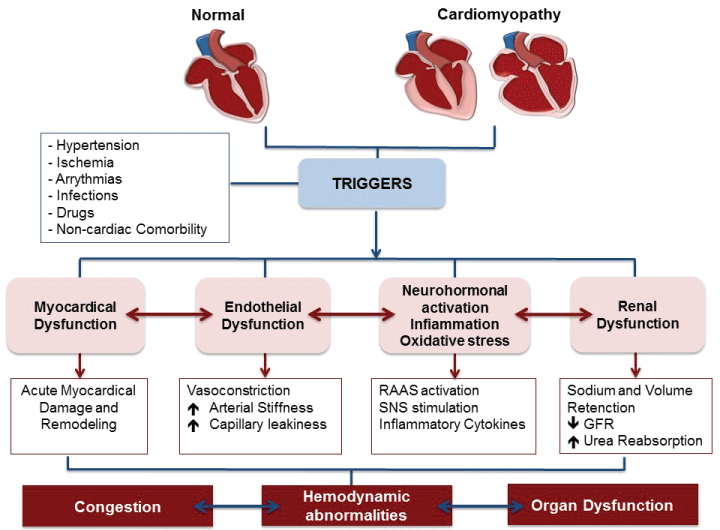Heart Failure
Introduction
- Heart failure (HF) is a common cardiovascular condition with increasing incidence and prevalence.
- Unlike western countries where heart failure is predominantly a disease of elderly, in India it affects younger age group.
Definition-Heart failure is a chronic condition in which the heart cannot pump enough blood and oxygen to support other organs in your body.(CDC- Centre of disease control & prevention)
Congestive heart failure (CHF)- is a chronic progressive condition that affects the pumping power of heart muscles. While often referred to simply as “heart failure,”
Types of Heart Failure
- Left-sided heart failure-Fluid may back up in your lungs, causing shortness of breath.
- Right-sided heart failure- Fluid may back up into your abdomen, legs and feet, causing swelling.
- Systolic heart failure- The left ventricle can't contract vigorously, indicating a pumping problem.
- Diastolic heart failure- The left ventricle can't relax or fill fully, indicating a filling problem. (also called heart failure with preserved ejection fraction)
Causes/Etiology-
1. Acute Factors-
- Acute myocardial infarction
- Pulmonary emboli
- Ventricular septal defect
- Myocarditis
- Dysrhythmias
- Thyrotoxicosis
- Hypertensive crisis
- Rupture of papillary muscles (mitral valve)
2.Chronic factors-
- Coronary artery disease
- Hypertensive heart disease
- Rheumatic heart disease
- Car pulmonale-Cor pulmonale, also known as pulmonary heart disease, occurs when a lung disorder leads to increased pressure in the pulmonary arteries, causing the right ventricle of the heart to enlarge and eventually fail.
- Anemia
- Valvular disorders
- Bacterial endocarditis
- Cardiomyopathy
- Congenital heart disease
Clinical Manifestations
- Shortness of breath (dyspnea) when you exert yourself or when you lie down
- Fatigue and weakness
- Swelling (edema) in your legs, ankles and feet
- Rapid or irregular heartbeat
- Reduced ability to exercise
- Persistent cough or wheezing with white or pink blood- tinged phlegm
- Increased need to urinate at night
- Swelling of your abdomen (ascites)
- Sudden weight gain from fluid retention
- Lack of appetite and nausea
- Difficulty concentrating or decreased alertness
- Sudden, severe shortness of breath and coughing up pink, foamy mucus
- Chest pain if your heart failure is caused by a heart attack.
Pathophysiology-

Diagnostic Studies
- History collection
- Physical Examination
- Blood tests- Like LFT, KFT & TSH
- A blood test to check for a chemical called N-terminal pro-B-type natriuretic peptide (NT-proBNP) may help in diagnosing heart failure
- Chest X-ray- heart may appear enlarged and fluid buildup may be visible in your lungs.
- Electrocardiogram (ECG)
- Echocardiogram
- Stress test- Stress tests measure how heart and blood vessels respond to exertion.
- Cardiac computerized tomography (CT) scan or magnetic resonance imaging (MRI).
- Coronary angiogram
- Myocardial biopsy
Management -
Medical management
1. Pharmacological Management
- Angiotensin-converting enzyme (ACE) inhibitors- enalapril (Vasotec), lisinopril (Zestril) and captopril (Capoten).
- Angiotensin II receptor blockers. losartan (Cozaar) and valsartan (Diovan)
- Beta blockers.-carvedilol , metoprolol (Lopressor) and bisoprolol Diuretics- furosemide (Lasix)
- Aldosterone antagonists- spironolactone (Aldactone)
- Inotropes- improve heart pumping function and maintain blood pressure.
- Digoxin (Lanoxin).
2. Non- Pharmacological Management
- Maintain input & output of the patient
- Propped up position of the patients
- Oxygen support should be provided to the patient.
Surgical Management
- Coronary bypass surgery
- Heart valve repair or replacement.
- Implantable cardioverter-defibrillators
- Cardiac resynchronization therapy (CRT), or biventricular pacing
- Ventricular assist devices (vads)
- Heart transplant
Nursing Management
Nursing Diagnosis
- Decreased cardiac output related to changes in myocardial contractility
- Ineffective breathing pattern related to insufficient supply of oxygenated blood.
- Excess fluid volume related to decreased glomerular filtration rate (GFR).
- "The patient is experiencing activity intolerance related to decreased cardiac output as evidenced by shortness of breath and fatigue upon exertion." .
- Anxiety related to breathlessness from inadequate oxygenation. Powerlessness related to chronic illness and hospitalizations. Ineffective therapeutic regimen management related to lack of knowledge.
Nursing Management of Heart Failure
1. Assessment
a. Monitor vital signs: BP, HR, respiratory rate, oxygen saturation.
b. Assess for signs of fluid overload:
- Edema (peripheral, sacral)
- Jugular vein distension (JVD)
- Crackles in lungs
- Weight gain
c. Evaluate cardiac function-
- Fatigue
- Dyspnea on exertion
- Orthopnea
- Paroxysmal nocturnal dyspnea
d. Monitor lab results-
- BNP (B-type natriuretic peptide)
- Electrolytes (especially potassium)
- Renal function (BUN, creatinine)
e. Assess medication adherence and lifestyle factors
2. Nursing Interventions
A. Promote Oxygenation
- Position patient in semi-Fowler’s to improve lung expansion.
- Administer oxygen therapy as prescribed.
- Monitor for signs of hypoxia.
B. Manage Fluid Volume
- Monitor daily weights (same time, same scale).
- Maintain accurate intake and output (I&O).
- Restrict fluids if ordered.
- Administer diuretics as prescribed (e.g., furosemide).
- Monitor for signs of dehydration or electrolyte imbalance.
C. Support Cardiac Output
- Administer cardiac medications as ordered:
- ACE inhibitors, beta-blockers, digoxin, diuretics.
- Monitor for side effects (e.g., bradycardia, hypotension).
- Encourage rest periods to reduce cardiac workload.
- Monitor ECG for arrhythmias.
D. Nutritional Management
- Educate on low-sodium diet (usually <2g/day).
- Monitor for nutritional deficiencies and appetite.
E. Prevent Complications
- Prevent Deep Vein Thrombosis (DVT)- To prevent DVT, nurses help patients walk as early as possible (early ambulation), and if patients can't walk, they may use Sequential Compression Devices (SCDs) to keep the blood flowing in the legs.
- Monitor for signs of worsening heart failure (e.g., increased dyspnea, rapid weight gain).
3. Health Education
- Smoking Cessation
- Discuss weight monitoring.
- Check legs, ankles and feet for swelling daily.
- Eat a healthy diet.
- Restrict salt in your diet & limit water
- Maintain a healthy weight.
- Limit fats and cholesterol.
- Limit alcohol and fluids.
- Active lifestyle
- Reduce stress & get proper sleep.